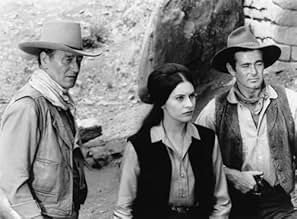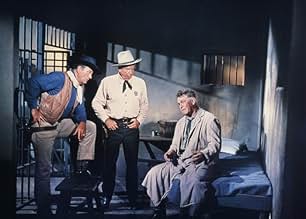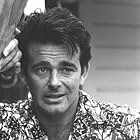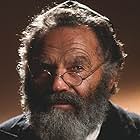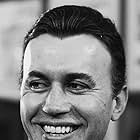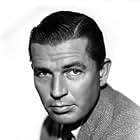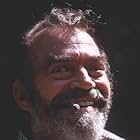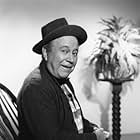Texas Ranger Jake Cutter arrests gambler Paul Regret, but soon finds himself teamed with his prisoner in an undercover effort to defeat a band of renegade arms merchants and thieves dealing ... Read allTexas Ranger Jake Cutter arrests gambler Paul Regret, but soon finds himself teamed with his prisoner in an undercover effort to defeat a band of renegade arms merchants and thieves dealing with the Comanches known as Comancheros.Texas Ranger Jake Cutter arrests gambler Paul Regret, but soon finds himself teamed with his prisoner in an undercover effort to defeat a band of renegade arms merchants and thieves dealing with the Comanches known as Comancheros.
- Awards
- 2 wins & 3 nominations
- Tobe
- (as Pat Wayne)
- Nervous Drunk
- (uncredited)
- Martha Schofield
- (uncredited)
- Comanchero
- (uncredited)
- Barfly
- (uncredited)
- Card Dealer
- (uncredited)
Storyline
Did you know
- TriviaGeorge Sherman produced this film, and Michael Curtiz directed it. During much of the shooting, Curtiz was seriously ill: he died of cancer shortly after the film's release. On the days when Curtiz was too ill to work, John Wayne took over direction. When the film was completed, he told the studio that he did not want credit as co-director and insisted that Curtiz's name alone appear as director. Wayne performed the same function in 1971 on "Big Jake (1971)," which was directed by Sherman, who took ill during production. Wayne directed the film on the days when Sherman couldn't and again insisted that he not receive co-director credit.
- GoofsThe guns used in the movie are Colt Single Action model 1873 revolvers, look-alike Henry lever-action model 1860 rifles, and Winchester model 1892 lever-action rifles. The only correct period guns are the single-shot percussion-cap dueling pistols used in the opening scene.
- Quotes
[while Regret and Cutter are tied up as prisoners]
Paul Regret: I wonder if they know how much trouble they're in.
- Alternate versionsWhen originally released theatrically in the UK, the BBFC made cuts to secure an 'A' rating. When released on home video in 1988, the BBFC made cuts of 11 seconds to remove shots of horse-falls to secure a 'PG' rating. For the DVD release, the BBFC made cuts of 8 seconds in 2003 to remove similar shots of horse-falls resulting in a 'PG' rating. To date (December 2014), the film has not been released fully uncut on UK media.
- ConnectionsFeatured in Hollywood Remembers Lee Marvin (2000)
- SoundtracksThe Comancheros
Music & Lyrics by Tillman B. Franks (as Tillman Franks)
In a way the movie is three movies, consisting of three separate but connected story arcs, any or each of which could have been beefed up and expanded into movies unto themselves. The story is thusly layered with complexity, which keeps it all interestingly moving along apace, never bogging down. It is also however the source of the movie's only real flaw. And that flaw is, as other reviewers have noted, the movie's presentation of a dubious and flawed historical chronology. And it isn't just little anachronisms like repeating rifles out of time. There is a complete confusion of historical eras and historical settings. Even though the story is set in 1843, its time seems to vacillate throughout, in one arc staying true to the story it is or purports to be, a story set in the antebellum south, but then jumping in another arc to a story appearing to be more similar to the further-western and decades later Indian wars, circa the 1870s. It seems as if there was lot of trouble deciding which of those two kinds of stories the movie was telling, a story about events in the antebellum south or a shoot-em-up story of the western Indian wars. It is likely a problem of scriptwriting, having had numerous "treatments" or rewrites by more than one writer, and those seams show. My guess is ultimately director Michael Curtiz and producer George Sherman must have decided that the typical ticket-buyers for this movie would be fans of John Wayne westerns, and that target audience would not be comprised of history majors or even history buffs, or be ones to get hung up on historical details, so they just let the historical flaws slip through.
There is one unintentionally funny moment in the movie. About mid-way through, watch for the blood-curdling scream by the bed-ridden lady (Joan O'Brien?) at the outpost when she looks out the window and sees the supposed Indian raiders crossing the river. It is truly a classic and world-class movie scream. I wonder how many takes that took.
One of the movie's three story arcs features Lee Marvin. This is a pre-Cat Ballou, pre-Dirty Dozen Lee Marvin who at this point in his career wasn't really yet a bigtime Hollywood household name, at least not like he would later become. Marvin turns in a marvelous over-the-top performance as a gun-dealing rapscallion, in my opinion flat-out stealing every scene he's in. That's no small feat, considering in all of his scenes he was playing directly off against John Wayne, who almost fades into the woodwork in the comparison. Actually Wayne sublimates himself quite well. He knew how to be a team player, and the chemisrty between Wayne and Marvin is good. Unfortunately this story arc is really nothing much more than a side-story than anything else, so Marvin's role is quite limited. Too bad. I would've liked to have seen a lot more of Marvin in this film. It would have been a better movie for it.
Lee Marvin, John Wayne and Marvin appeared together again two years later in John Ford's Donovan's Reef, with Marvin again playing a lesser role.
This movie pops up regularly on the Encore Westerns channel. I've seen it there about 5 times over the last 6 months. Watch for it.
- tightspotkilo
- Sep 29, 2005
- Permalink
Details
Box office
- Budget
- $4,260,000 (estimated)
- Runtime1 hour 47 minutes
- Color
- Aspect ratio
- 2.35 : 1
Contribute to this page



